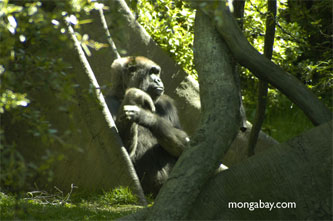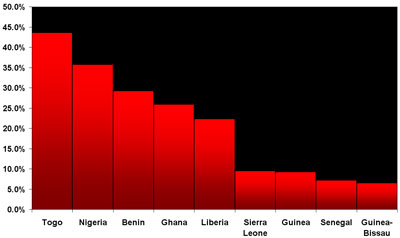Goodbye to West Africa’s Rainforests
Rhett A. Butler, mongabay.com
January 22, 2006
The state of West Africa’s rainforests
West Africa’s once verdant and extensive rainforests are now a historical footnote. Gone to build ships and furniture, feed hungry mouths, and supply minerals and gems to the West, the band of tropical forests that once extended from Guinea to Cameroon are virtually a memory. The loss of West Africa’s rainforests have triggered a number of environmental problems that have contributed to social unrest and exacerbated poverty across the region.
Disappearing forests
According to data provided by the United Nations, today about 1.5% of West Africa has primary forest cover. In the past 15 years, more than 5400 square miles (1.4 million hectares), or 26 percent, of primary—or old growth—forest has disappeared from the region, leaving West Africa with somewhere between 11,600 and 15,400 square miles (3 and 4 million hectares) of such forest.
West Africa’s impoverishment of old-growth forest is a relatively new development. One hundred years ago, West Africa had some 193,000 square miles (50 million hectares) of coastal rainforest, but decades of relentless logging combined with road-building, mining, and subsistence activities including the collection of fuel wood and agricultural clearing for subsistence has left the region with precious little forest. High population growth rates have only worsened the loss—deforestation rates of primary forest have increased by more than 20% since the close of the 1990s.
Civil strife
Forest loss has made life more difficult for millions of West Africans who depend upon forests for meeting their most basic needs. Environmental degradation including soil erosion, desertification, and reduced agricultural productivity, and the ongoing struggle for resources has made the region one of the most unstable in the world. In the past ten years, brutal wars waged by child soldiers have broken out Liberia and Sierra Leone, while Côte d’Ivoire—once the economic success story of West Africa—collapsed in civil strife. Nigeria’s oil-producing Niger River delta has been the scene of bloody uprisings and terrific animosity between local residents and oil companies. At times, unrest has threatened to destabilize neighboring countries as well.
Biodiverse landscape
 |
The continuing disappearance of West Africa’s forests is putting pressure of the region’s incredible biodiversity. Home to more than a quarter of Africa’s mammals, including lowland gorillas and chimpanzees, and more than 1,800 endemic species of plants, West Africa has been named one of the world’s 34 biodiversity hotspots by Conservation International (CI), a leading global conservation organization.
Its designation as a global biodiversity hotspot means that conserving West Africa’s remaining forests is a top priority for scientists and international conservation groups. While more than 17 percent of the region’s forests is technically under some form of protection, CI notes that a mere 3 percent of the area is conserved for biodiversity purposes. Moreover, says CI. forest reserves are under increasing threat from logging, agricultural conversion, and bushmeat hunting, and it is uncertain whether existing government action will be sufficient to protect them in the future.
 |
Protecting West African’s remaining forests promises to be a formidable challenge in a land where rural communities living adjacent to protected areas rely on forest resources to provide them with food and building materials. Currently, conservation organizations are focusing on community development initiatives that provide alternative sources of income for local residents. According to CI, ecotourism, the fabrication of handicrafts and agroforestry all show promise for poverty alleviation, but governments and international funders will also have to be on board to make conservation efforts successful in the long run.
Note
For the purpose of this assessment, West African countries include:
Benin, Cote d’ Ivoire (Ivory Coast), Equatorial Guinea, Gambia, Ghana, Guinea, Guinea-Bissau, Liberia, Nigeria, Senegal, Sierra Leone, and Togo. The Congo rain forest is part of “Central Africa”. Primary forest is defined by the Food and Agriculture Organization of the United Nations (FAO) as forests with no visible signs of past or present human activities. Primary forest figures for Côte d’Ivoire, Ghana, Guinea, Guinea-Bissau, and
Liberia have not been updated by FAO since 1990. Based on total deforestation rates for these countries, primary forest cover is almost certainly at least 10 percent lower than indicated by current FAO figures.